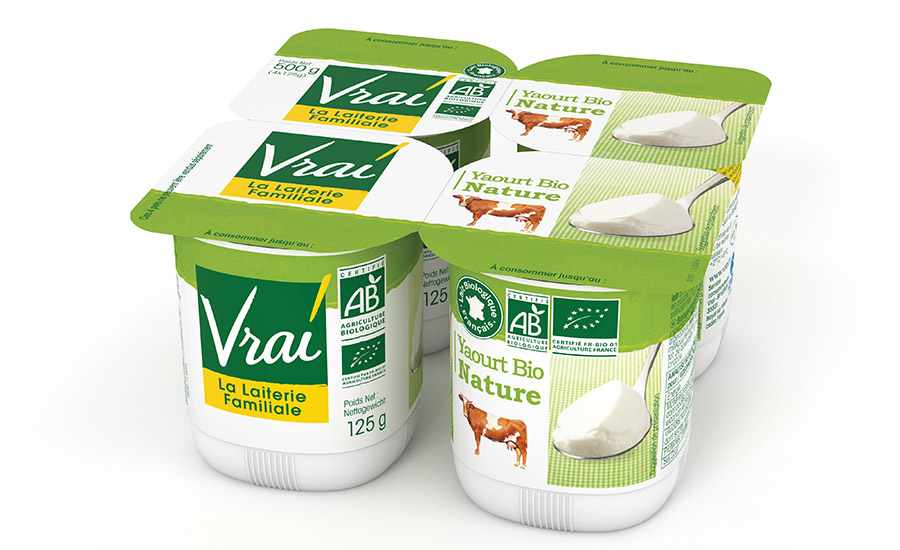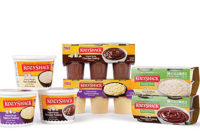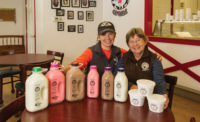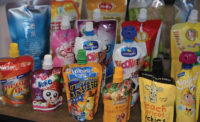With unit volume sales of dairy packaging projected to grow 6% by 2019, the industry’s manufacturers embrace packaging innovations that convey product benefits while providing convenience and freshness. These demands underlie brand managers’ inclinations toward thin-wall plastic containers, stand-up pouches, resealable closures and transparent packaging.
Processing and packaging technology suppliers can expect to see the latest innovations in packaging for milk, cheese, yogurt and other dairy products at Pack Expo International 2016 (Nov. 6-9 at McCormick Place, Chicago).
A custom experience with thin-wall plastic
Thin-wall plastic containers are the most prominent packaging in dairy, with a 3% compound annual growth rate from 2014-2019, according to Chicago-based Mintel. Although it is an ever-present format for products such as yogurt, brand owners have taken a new direction by shaping the thin-wall containers into two-compartment tubs (or split-pots). Greek yogurt manufacturers have also adopted the format, situating the yogurt apart from its sweet “topping” ingredients so consumers can mix them when they’re ready to snack. Not only does the shape of the package stand out on shelves, but this design allows consumers to mix the yogurt with the topping to their taste for a customized product experience. The Chobani Flip Line is packaged in a two-compartment polystyrene container. Fage utilizes this format as well with its Total 0% split cup yogurt.
Flexing the creative muscle
Dairy brand owners looking hard to break the retail shelf landscape are turning their attention to stand-up, flexible pouches. For example, Stonyfield introduced the first refrigerated yogurt to be available in pouch format in August 2014, according to Euromonitor. Chobani followed in early 2015 with a line of Greek yogurt pouches for children.
According to Mintel’s 2016 global packaging report, 32% of consumers associate flexible packaging with innovation. Brands that tap into flexible packaging also have an unmatched opportunity to decorate and market the product so that it resonates with consumers at point of purchase. Moreover, it provides ample prospects for features like slider and press-to-close zipper closures, perfect for multiple servings on the go.
Younger shoppers also prefer resealability features to preserve product freshness. In fact, 23% of Millennials – the largest generation in U.S. history – use resealability to decide the freshness of food they buy from the store. As a result, closures can contribute to brand loyalty. For example, consumers are more likely to go for brands that offer a flexible pack of hard cheese with a zip closure as it will help preserve the freshness of the product, according to Euromonitor, Chicago.
Show and tell transparency
As consumers become more health-conscious, they prefer to know what is in their food and how it looks. Today, 70% of grocery shoppers look for ingredients listed on food packaging. Additionally, more than 30% of consumers are cautious when serving foods with preservatives compared to 24% 10 years ago, and the trend for additives follows the same progression, according to The NPD Group, Port Washington, N.Y.
Accordingly, packaging that communicates about product freshness, wholesomeness and nutritional benefits is set to increase in popularity. Clear labeling is the key. For example, organic milk sales grew from $82 million to $121.7 million from 2013-2015 — a 29.4% increase, according to Mintel. The same report found that organic yogurt sales also rose 35% over the same period – from $61.3 million to $82.7 million. Essentially, brands that emphasize benefits such as “organic,” “gluten-free” and “all-natural” on their packaging and labels inform shoppers of the attributes they may be looking for in products.
Furthermore, the concepts of clean labeling and straightforward on-pack communication are set to merge. Manufacturers, including Danone, are redesigning their packaging in response to the rising see-through packaging trend. Direct and concise information on ingredients, functional product attributes, or even convenience and safety must be communicated with complete transparency – a key responsibility brands and consumers are placing on packaging.
Pack Expo showcases the latest
To appeal to today’s on-the-go, health-conscious consumer, dairy manufacturers are using packaging to offer convenience and communicate the nutritional value and freshness of their products. In a world where convenience is king, brand owners seek out dairy packaging that meets consumer demand for enhanced functionality and stands out on the store shelf. At this year’ Pack Expo International, brand owners will have the opportunity to connect with suppliers of a wide range of packaging machinery, materials and containers to discover the solutions to help them achieve their goals. Until then, PMMI’s latest dairy industry report will be available in the spring. Dairy manufacturers can visit www.pmmi.org for more information on PMMI’s industry reports. To learn more about Pack Expo International 2016, visit packexpointernational.com. Attendee registration is now open.







